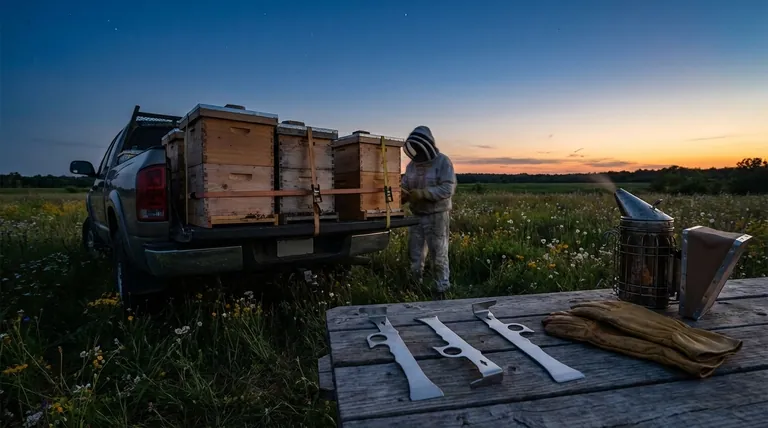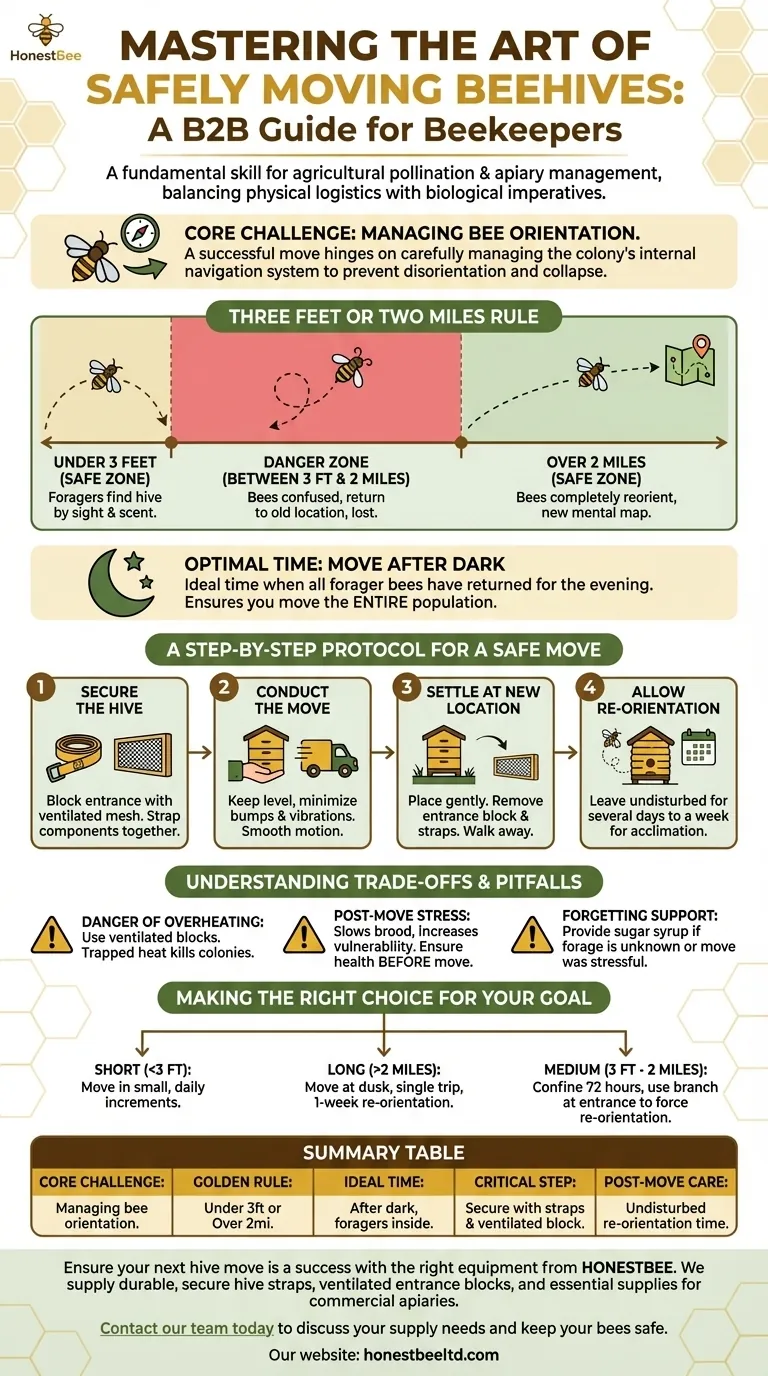Mastering the art of moving a beehive is a fundamental skill for any serious beekeeper. It is essential for those who transport colonies for agricultural pollination and for hobbyists who simply need to reorganize their own bee yard for better sun exposure or accessibility. The process, however, is delicate and requires a precise methodology to ensure the colony's safety and prevent disorientation.
The core challenge of moving a hive isn't the physical weight, but the biological imperative of the bees. A successful move hinges on carefully managing the colony's internal navigation system and minimizing stress to prevent collapse or absconding.

The Core Challenge: Bee Orientation
Understanding how bees navigate is the key to moving them successfully. Forager bees create a mental map of their hive's precise location and will return to that exact spot after foraging. Moving the hive incorrectly confuses this internal GPS, causing chaos and potentially costing you thousands of bees.
The "Three Feet or Two Miles" Rule
This is the cardinal rule of moving hives. It’s based on the bees' orientation patterns.
A move of less than three feet is small enough that returning foragers can still locate the hive entrance by sight and scent.
A move of more than two miles forces the bees to completely reorient themselves, creating a new mental map centered on the new location.
Any distance between these two points is the danger zone, as bees may become confused and return to the original spot, unable to find their colony.
Why Night is the Right Time
The ideal time to move a hive is after dark. By nightfall, all the forager bees have returned from the fields and are inside the hive for the evening.
Moving the colony at this time ensures you are moving the entire population and not leaving a significant portion of your workforce behind to perish.
A Step-by-Step Protocol for a Safe Move
A successful move requires careful preparation, execution, and post-move care. Haste and carelessness are the enemies of a healthy colony.
Step 1: Secure the Hive
Before any movement, you must block the hive entrance. Use a material like wire mesh or a dedicated entrance block that prevents bees from escaping but still allows for critical airflow.
Next, use straps to secure all hive components together—the bottom board, brood boxes, supers, and lid—so they don't shift or separate during transport.
Step 2: Conduct the Move
When lifting and carrying the hive, the goal is to keep it level and minimize bumps and vibrations. Abrupt movements can disturb the comb, agitate the bees, and increase stress.
Whether using a vehicle or carrying it by hand, smooth and steady motion is paramount.
Step 3: Settle at the New Location
Once at the new site, place the hive gently in its final position. You can now remove the entrance block and unwrap any straps.
It's best to do this and then walk away immediately. The bees will be disoriented and defensive, and giving them space is crucial.
Step 4: Allow for Re-orientation
Leave the hive undisturbed for several days to a week. The bees need this time to acclimate, perform new orientation flights, and map their new surroundings.
Resist the urge to perform an inspection too soon. Opening the hive adds unnecessary stress during this critical adjustment period.
Understanding the Trade-offs and Pitfalls
Even a well-executed move carries risks. Being aware of them allows you to mitigate potential problems before they escalate.
The Danger of Overheating
Blocking the entrance traps heat inside the hive. If you use a solid block with no ventilation, especially on a warm night or during a long-distance move, the colony can quickly overheat and die.
Always use a screened entrance block or ensure another source of ventilation is available.
Post-Move Stress
Moving is stressful for a bee colony. This stress can temporarily slow brood production and make the colony more susceptible to pests or disease.
Ensuring the colony is strong and healthy before the move is one of the best ways to guarantee a successful outcome.
Forgetting Post-Move Support
If you've moved the bees to an area with unknown forage, or if the move was particularly stressful, consider providing a feeder with a light sugar syrup. This ensures they have immediate access to carbohydrates to fuel their re-orientation efforts without depleting their stores.
Making the Right Choice for Your Goal
Your approach depends entirely on the distance of the move. Following the correct protocol for your situation is non-negotiable for the colony's survival.
- If your primary focus is a short-distance adjustment (under 3 feet): Move the hive in small, daily increments until you reach the desired location.
- If your primary focus is a long-distance relocation (over 2 miles): Prepare the hive at dusk, move it in a single trip, and allow a full week for the colony to reorient before performing any inspections.
- If you must move a hive a medium distance (between 3 feet and 2 miles): Confine the bees for 72 hours and place a large branch in front of the entrance upon release to force them to reorient immediately.
Ultimately, a calm, methodical, and bee-centric approach is what separates a successful hive relocation from a disastrous one.
Summary Table:
| Key Consideration | Description |
|---|---|
| Core Challenge | Managing bee orientation to prevent foragers from getting lost. |
| Golden Rule | Move less than 3 feet or more than 2 miles to avoid the 'danger zone'. |
| Ideal Time | Move after dark when all foragers are inside the hive. |
| Critical Step | Secure the hive with straps and a ventilated entrance block before moving. |
| Post-Move Care | Leave the hive undisturbed for several days to allow for re-orientation. |
Ensure your next hive move is a success with the right equipment from HONESTBEE. We supply durable, secure hive straps, ventilated entrance blocks, and other essential beekeeping supplies designed for the rigorous demands of commercial apiaries and beekeeping equipment distributors. Our wholesale-focused operations ensure you get reliable gear that protects your valuable colonies during transport. Contact our team today to discuss your supply needs and keep your bees safe.
Visual Guide

Related Products
- HONESTBEE Advanced Ergonomic Stainless Steel Hive Tool for Beekeeping
- Professional Dual-End Stainless Steel Hive Tool for Beekeeping
- Professional 3-Bar Frame Grip with Integrated Hive Tool
- Professional Galvanized Hive Strap with Secure Locking Buckle for Beekeeping
- Plastic Bee Hive Stand for Beekeeping
People Also Ask
- How is a hive tool used for scraping and cleaning? Master Hive Maintenance for a Healthy Colony
- What is the hole in a hive tool for? A Multi-Tool for Apiary Repairs and Maintenance
- What tools are used for cleaning frames? A Beekeeper's Simple 4-Tool Guide
- What are the features of a regular hive tool? The Essential Multi-Tool for Every Beekeeper
- Why is it important to compare the progress of different hives? A Beekeeper's Key Diagnostic Tool



















